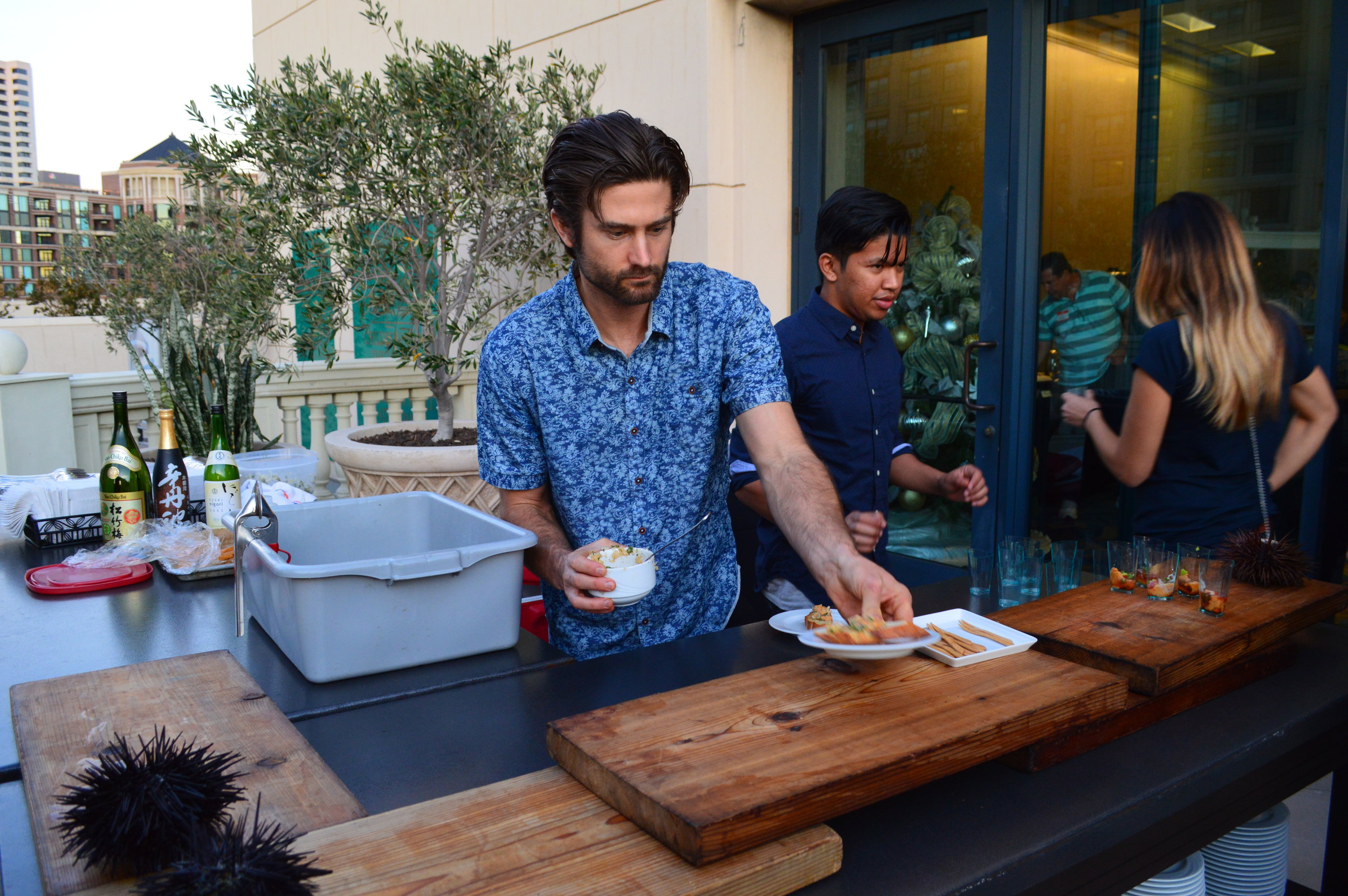By Kathryn Rogers and Sarah Shoffler, Slow Food Urban San Diego Board Members
Slow Food Urban San Diego (SFUSD) joined the San Diego Food System Alliance (SDFSA), local fishermen, scientists, government leaders and community partners this week in celebration of local fisheries.
On December 7, 2015, more than 100 fish-loving friends gathered together at the waterfront Manchester Grand Hyatt San Diego for inspiring speeches, a lively panel discussion and delicious local seafood served in honor of the recent passage of the “Pacific to Plate” bill AB226. The new bill, sponsored by Speaker Toni Atkins (D-San Diego) and signed into law in October by Governor Jerry Brown, allows fishermen’s markets to operate as food facilities, vendors to clean their fish for direct sale, and multiple fishermen to organize a market under a single permit. Put simply, the bill makes it easier for fishermen to sell directly to the public, much like farmers can.
The process to develop the bill sprung from the early success of Tuna Harbor Dockside Market (THDM), which opened to the public in August 2014 and averaged more than 350 customers and 1.1 tons of seafood sold each week in its first months of operation. Recognizing the potential of a longer-term, direct-to-consumer market (the original operated under a temporary permit), County Supervisor Greg Cox, the County’s Department of Environmental Health, Port Commissioner Bob Nelson, the Unified Port of San Diego, California Sea Grant, NOAA, California Restaurant Association, The Maritime Alliance, California Coastal Conservancy, the local media, fishermen, researchers and supporters collaborated to draft a bill that met the desires of local fishermen and consumers. It received unanimous support in the California Assembly and Senate.
How does the new bill align with Slow Food’s mission of Good, Clean and Fair Food for All?
Good: The bill makes it easier for local fishermen to sell directly to consumers, and eliminates added transit time and processing/freezing compared to seafood imported from other countries or regions. The fish sold at THDM is caught by San Diego fishermen in local waters, most of it coming out of our oceans no more than a couple of days before it ends up in consumers’ kitchens. If you’ve ever tasted fresh caught sea urchin (a San Diego local favorite), you can tell the difference - big time. If you haven’t, get yourself down to THDM for an uni scramble or shooter. Your taste buds may never be the same.
Clean: Local sourcing means a smaller carbon footprint - no added fuel costs for fish flown or trucked to our markets from other states and countries. And US fisheries are among the most stringently regulated the world, meaning that if there’s a problem – either we’re fishing them too fast, there are too few or we’re catching protected species, we are mandated to do something about it. Our fishermen are required to stop fishing, slow fishing, or change fishing practices in some way to ensure we’re fishing sustainably.
Fair: One of the greatest benefits of a true fishermen’s market is that it promotes collaboration among local fishermen. Take it from fisherman Pete Halmay, a member of the Fishermen’s Market Working Group and longtime sea urchin diver:
“One of the best things I've seen with this direct market is that every Saturday 10 to 12 fishermen sit down together, work together, to maximize the benefits to the population. They are bringing in a wider variety of fish so each fisherman can generate more sales and bring more diverse options to consumers.”
San Diego’s seafood is wide-ranging indeed. We don't have just tuna and shrimp (two of the most commonly eaten seafood products in the US) in our waters. Our harbors and oceans are full of rockfish (dozens of species!), crab, lobster and snails, among other smaller fish like sardines, sand dabs, and mackerel.
For All: The direct-to-consumer market allows fishermen to run specials when they catch a big run of fish, passing the abundance onto consumers in the form of lower prices.
The passage of the Pacific to Plate bill is a major milestone in bringing good, clean and fair seafood to all San Diegans. So what’s next?
During Monday’s event, Dr. Theresa Sinicrope Talley, Coastal Specialist for the California Sea Grant Extension at Scripps Institution of Oceanography at UC San Diego moderated an expert panel that raised some important questions about where we can go from here to create an even more sustainable seafood system. Barriers to getting seafood from dock to dish still remain, including:
Lack of infrastructure for San Diego fishermen to offload their catch at local docks.
Logistical constraints including limited market hours (currently Tuna Harbor Dockside Market is only open Saturdays from 8 a.m. until around 1 p.m.) that make it hard from some consumers and chefs to get there.
Limited awareness among locals and visitors that the market exists, where else they can buy local seafood, and how they can prepare the less well known seafood produced locally.
Stay tuned for local efforts to address these issues. In the meantime, SFUSD is seeking local chefs and community partners interested in collaborating on these efforts. Contact us to learn more.
And, be sure to pay a visit to THDM to see these fish tales come to life. While you’re there, make sure to ask your local fishermen for their favorite seafood preparations!






